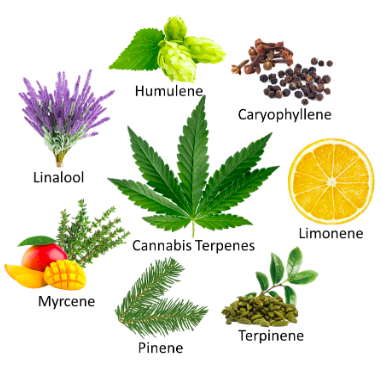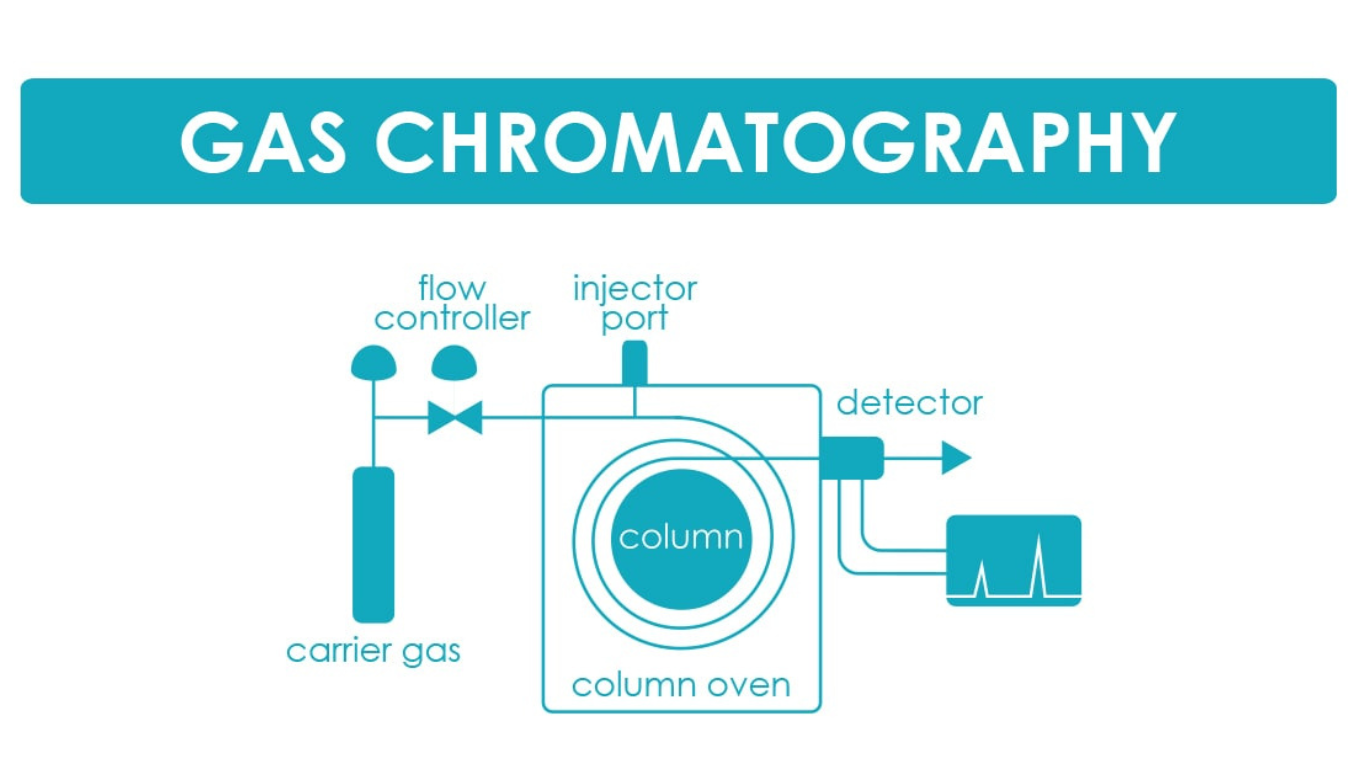If you have ever wondered why cannabis and hemp buds can have wildly different aromas and tastes, part of the answer lies within the terpenes that the product contains. Using cannabis and hemp terpene testing, Modern Canna identifies unique fingerprints within a product to provide consumers with key information about how the product will smell, taste, and the effects it will produce when used.
Modern Canna is proud to be the only certified Leafly partner in the state of Florida. Modern Canna’s state-of-the-art testing lab offers superior accuracy and reproducibility in cannabis and hemp terpene testing.
What are Terpenes?
Terpenes are volatile organic compounds (VOCs) that are produced primarily by plants. While they do provide various scents and aromas, they are primarily created to protect the plants from danger and to attract pollinators. Terpenes exist all throughout nature and are found in materials that are encountered on a daily basis. For example, myrcene is found in mangos and thyme, limonene is present in lemons and other citrus fruits, humulene exists in hops, and linalool is prevalent in lavender. Since these organic molecules exist naturally and can be found in relatively large abundances, they often serve as the foundation for various essential oils. Additionally, terpenes possess medicinal properties, some of which include antioxidants and analgesics. It has also been noted that some terpenes produce anti-inflammatory and antimicrobial responses in the body.
What are Cannabis and Hemp Terpenes?
Terpenes that are found in cannabis and hemp are responsible for the complex aromas associated with the plants, some of which may result in the plant taking on pine, citrus, sweet berry, clove, mint, or earthy flavor profiles. Over 150 different types of terpenes have been identified in the cannabis and hemp plant. Typically, each cultivar has its own aromatic diversity. This is due to the terpenes that exist as a result of the unique genetics that each plant possesses. Terpene profiles are similar to fingerprints, meaning that it is difficult to find two cultivars that will express identical profiles. While terpenes normally receive less attention than cannabinoids, it is important to understand that these compounds can impact the overall appeal of a product and can provide additional medicinal benefits.
While the list of potential terpenes that can be present in cannabis is extensive, there are a handful of specific terpenes that are considered dominant and help determine the most prevalent smell, aroma, and medicinal benefits that the flower will exhibit. Some of these dominant cannabis terpenes include:
- Linalool Dominant Cultivars – produce a floral, candy-like aroma. In addition to being found in cannabis, this terpene also exists in lavender and coriander. Research suggests that linalool will reduce pain, insomnia, depression, anxiety, and seizures.
- Myrcene Dominant Cultivars – produce a musky and earthy aroma that sometimes has notes of tropical fruit. This terpene is also found in mangos, lemongrass, eucalyptus, and hops. Research suggests that myrcene may treat spasms, pain, insomnia, depression, and inflammation.
- Limonene Dominant Cultivars – produce a bitter, citrus-like aroma. In addition to cannabis, this terpene can be found in lemon, peppermint, rosemary, and juniper. Research suggests that this terpene has anti-fungal and anti-inflammatory properties and may be able to alleviate stress and depression.
- Caryophyllene Dominant Cultivars – produce a rich, spicy aroma. This terpene can be found in cloves and black pepper. Caryophyllene is known for its anti-inflammatory, anti-bacterial, anti-fungal, and antiseptic properties.
- Pinene Dominant Cultivars – produce a sweet pine aroma. In addition to being found in cannabis, this terpene is also present in pine needles, dill, parsley, and basil. Research suggests that pinene may help treat inflammation and may improve alertness and memory.
- Humulene Dominant Cultivars – produce an earthy and spicy aroma. This terpene is predominantly found in hops and coriander. Humulene is known for its anti-inflammatory, anti-cancer, and antimicrobial properties.
- Terpinene Dominant Cultivars – produce a sweet citrus aroma. In addition to being found in cannabis, this terpene also exists in tea-tree oil, eucalyptus, and cardamom. Research suggests that terpinene produces a sedative effect and has antimicrobial, anti-inflammatory, and analgesic properties.
What are the Benefits of Terpenes?
While the flavor and aroma attributes of cannabis terpenes tend to be the main focus, these compounds provide much more to the plant and the consumer. As more research is conducted on cannabis terpenes and hemp terpenes, the industry is learning about their medicinal benefits. It has been determined that some terpenes are able to bind to receptor sites in the brain, thus, allowing them to affect the production of dopamine and serotonin. Additionally, research suggests that terpenes may work in a synergistic manner with cannabinoids to create what is known as the entourage effect.
Luckily, since many terpenes naturally exist in other materials, their medicinal benefits are well-known. Some of these medicinal benefits include anti-inflammatory, antioxidant, antidepressant, anti-cancer, antimicrobial, analgesic, and anticonvulsant properties. As such, particular cannabis and hemp terpenes have been shown to relieve the following:
- Stress
- Pain
- Insomnia
- Anxiety
- Depression
- Nausea
- Inflammation
The Entourage Effect of Terpenes

- Caryophyllene and Myrcene may have a synergistic relationship with THC, CBD, and CBN that promotes better sleep.
- Linalool and Limonene may have a synergistic relationship with CBD that could increase the efficacy of CBD.
- Myrcene, Caryophyllene, and Pinene may have a synergistic relationship with CBD that could help in treating addiction.
By understanding the terpene and cannabinoid profile of a particular cultivar, medical marijuana patients can make more informed decisions about the medicinal effects they may experience when using a product.
What are the Benefits of Terpene Testing?
Testing cannabis and hemp for the terpene profile is beneficial to cultivators, processors, healthcare providers, and consumers for a variety of reasons, some of which include:
- Determining the types and ratios of each terpene present in a specific product
- Understanding each cultivar’s terpene profile
- Recognizing phenotypic differences for the same cultivar
- Identifying the right cultivar to help relieve a patient’s symptoms
- Providing guidance to consumers about the potential effects that will be experienced when consuming a product
How is Terpene Testing Performed?
Modern Canna uses gas chromatography with mass spectrometry (GCMS) to separate and quantify over 40 terpenes. This principle involves injecting the sample into a GC column that will allow the molecules to be separated based on their polarity and size. After the compounds of interest are separated, the mass spectrometer will break the compounds into specific mass fragments that can be matched to a database, thus identifying each terpene that is present. The laboratory uses certified reference materials (CRMs) for each compound being measured to create a calibration. By doing this, the laboratory is able to quantify the amount of each terpene that is present. The extraction technique and sample preparation for this analysis is dependent on the matrix of the samples.
Future Developments in Terpene Testing
It is evident that cannabis and hemp cultivation has evolved significantly, with a growing emphasis on cultivar selection and breeding to enhance terpene profiles. Additionally, as the medical community learns more about the benefits of terpenes and the impact they can have on a patient’s health, accurate and reliable testing will play an instrumental role in ensuring that consumers receive the proper information about the products they are purchasing. At Modern Canna, we are committed to upholding our esteemed reputation by providing a comprehensive range of analytical solutions tailored to the specific needs of customers. Our dedication to precision and excellence ensures that we remain at the forefront of the cannabis testing industry. To learn more about our cannabis testing contact us today!
Resources:
- Alchimia Grow Shop. (2019, December 23). Marijuana terpenes and their effects. Alchimia Grow Shop. https://www.alchimiaweb.com/blogen/marijuana-terpenes-effects/.
- Cassiday, L. (2016, October). The Highs and Lows of Cannabis Testing. AOCS. https://www.aocs.org/stay-informed/inform-magazine/featured-articles/the-highs-and-lows-of-cannabis-testing-october-2016.
- Cox-Georgian, D., Ramadoss, N., Dona, C., & Basu, C. (2019). Therapeutic and medicinal uses of Terpenes. Medicinal Plants, 333–359. https://doi.org/10.1007/978-3-030-31269-5_15.
- Infographic: How Do Cannabis Terpenes Affect the Body?. Leafly. (2015, October 15). https://www.leafly.com/news/cannabis-101/infographic-what-are-cannabis-terpenes-and-how-do-they-affect-you.
- Nuutinen, T. (2018). Medicinal properties of terpenes found in Cannabis Sativa and humulus lupulus. European Journal of Medicinal Chemistry, 157, 198–228. https://doi.org/10.1016/j.ejmech.2018.07.076.
- Russo, E. B. (2011). TAMING THC: Potential cannabis synergy and phytocannabinoid‐terpenoid entourage effects. British Journal of Pharmacology, 163(7), 1344–1364. https://doi.org/10.1111/j.1476-5381.2011.01238.x.
- Stone, E. (2021, November 10). What are cannabis terpenes and what do they do?. Leafly. https://www.leafly.com/news/cannabis-101/terpenes-the-flavors-of-cannabis-aromatherapy.





